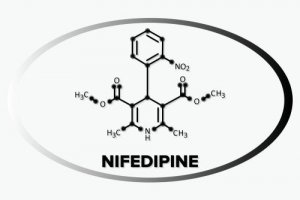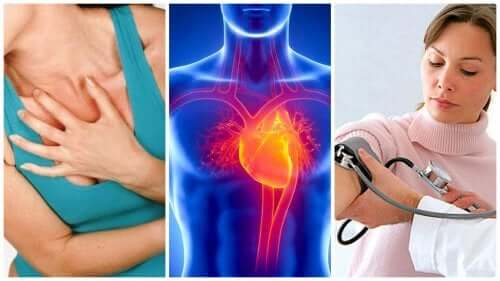Nifedipine - Characteristics and Indications

Nifedipine is a calcium antagonist that belongs to the dihydropyridine medication group. In addition, it’s a peripheral, hypotensive vasodilator and also has a low negative inotropic effect.
Because of these effects, doctors prescribe this medication for the treatment of angina pectoris and high blood pressure. There are quick-release capsules available as well, they’re useful in the treatment of Raynaud’s syndrome.
The routes of administration of this medication are oral and sublingual. Patients who can’t swallow opt for the second route of administration – in hypertensive crises, for example.
However, the sublingual route can be dangerous and isn’t widely recommended. This is because the hypotensive response it induces is intense and often difficult to control.
In addition, you must note that it’s not a good idea to drink grapefruit juice while you undergo treatment with nifedipine. The same goes for taking it when you’re also taking other substances that inhibit liver metabolism. This is because they may considerably increase the concentration of the drug and lead to toxicity.
What’s Raynaud’s syndrome?
This is a rare disease that affects the blood vessels of your fingers and toes. They narrow when a person is cold or under stress.
When this occurs, the blood cannot circulate properly due to the said vasoconstriction. As a result, the affected parts become whitish and bluish.
Once a person recovers from it, the skin becomes red and the patient may feel tingling and palpitations. But, when it worsens, it may lead to skin sores and even to necrosis.
The causes of Raynaud’s are still unknown. In addition, you must know how to differentiate between primary and secondary Raynaud. This is because the primary is the most frequent form and not the cause of associated disease.
As for secondary Raynaud, it’s due to an undiagnosed problem. It’s usually more serious than the primary one despite being less frequent. Some of the diseases that can trigger this syndrome are:
- Connective tissue disorders
- Arterial diseases
- Carpal tunnel syndrome
- Smoking
- Hand and feet injury
Discover: Five Herbs that You Can Prepare to Treat Hypertension
Mechanism of action – how does Nifedipine exert its effect?

Nifedipine, as we mentioned above, belongs to the calcium antagonist medications. This group reduces the absorption of calcium by the myocardial cells and blood vessels – all as a result of the blockage of voltage-dependent calcium channels.
In addition, Nifedipine belongs specifically to the dihydropyridine group. It mainly acts upon the peripheral circulation by relaxing the vascular smooth muscle and produces vasodilation of the arteries on two levels:
- Peripheral vasodilation. Here, the drug reduces afterload resistance. This is why Nifedipine is helpful in patients with high blood pressure and Raynaud’s syndrome.
- Coronary vasodilation. In this case, the drug increases coronary blood flow and myocardial oxygenation. This is why this medication is efficient in the treatment of angina pectoris.
Likewise, it can also decrease the cardiac conduction and contractility, though slightly.
Read also: How to Change Your Lifestyle if You Have Hypertension
Contraindications and adverse reactions of Nifedipine

Before you begin treatment with this medication, you must take into account a series of contraindications due to its possible side effects. Most importantly, a patient shouldn’t take Nifedipine if they’re allergic to it.
In turn, pregnant or breastfeeding women should avoid the use of this drug as it could affect the baby. Finally, and based on the data available for other medications in this family, people undergoing treatment with Rifampicin should avoid it as well.
Similarly, like most medications on the market, Nifedipine can trigger some side effects that you must take into account. Among them:
- Vascular problems related to vasodilation such as dizziness, headache, and peripheral edema
- Cardiac disorders such as palpitations, hypotension, and heart failure
- Digestive alterations
- Changes in the nervous system, such as anxiety and insomnia
Conclusion
Nifedipine is a medication primarily used in the treatment of hypertension, Raynaud’s syndrome, and angina pectoris. You must be especially careful with it due to its potency.
Consult your doctor or pharmacist with any questions you may have about this drug and always follow their instructions.
All cited sources were thoroughly reviewed by our team to ensure their quality, reliability, currency, and validity. The bibliography of this article was considered reliable and of academic or scientific accuracy.
- José Sandoval, M. S. (2003). Nifedipino versus ritodrina en la amenaza de parto pretermino.pdf. Revista Peruana Ginecología y Obstetricia.
- Puigventós Latorre, F., Carrillo Guivernau, L., Ramis Barceló, M., Galán Ramos, N., González González, L., & Usandizaga Calparsoro, M. (2014). Estudio observacional de la efectividad y seguridad de nifedipino en la amenaza de parto prematuro. Progresos de Obstetricia y Ginecologia. https://doi.org/10.1016/j.pog.2014.07.003
- Montes Santiago, J., Inaraja Bobo, M. T., & del Campo Fernández, V. (2003). Nifedipino oral o sublingual: Utilidad y efectividad a largo plazo de la educacin médica para disminuir su uso en la hipertensión. Revista Clinica Espanola. https://doi.org/10.1157/13042182
This text is provided for informational purposes only and does not replace consultation with a professional. If in doubt, consult your specialist.








